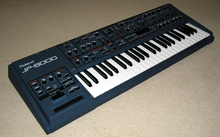Supersaw
| JP-8000 | |
|---|---|
 |
|
| Manufacturer | Roland |
| Dates | 1996 - 2001 |
| Technical specifications | |
| Polyphony | 8 voices |
| Timbrality | 2 |
| Oscillator | 2 oscillators per voice / sync OSC1 types : Super Saw / Triangle mod / noise / Feedback / Square / Saw / Triangle. OSC2 types : Square / Saw / Triangle |
| LFO | 2 sawtooth/square/triangle/sh |
| Synthesis type | Virtual analog Subtractive |
| Filter | 1 12dB / 24dB resonant lowpass/highpass/bandpass |
| Attenuator | 2 ADSR |
| Aftertouch expression | No |
| Velocity expression | Yes |
| Storage memory | 128 presets/128 user patches 64 preset performances/64 user performances |
| Effects | Chorus, delay, 2 band EQ / ring modulator |
| Input/output | |
| Keyboard | 49 keys |
| External control | MIDI |
The Roland JP-8000 is an analog modeling synthesizer released by the Roland Corporation in 1996.
The Roland JP-8000 was released in early 1997 as part of the first wave of virtual analog modeling synthesizers (VA synths). Others from that period included the Clavia Nord Lead (1995), Korg Prophecy (1995), Access Virus (1997) and Yamaha AN1x (1997). While the functionality, sound, and architecture of the JP-8000 differs from these other synthesizers, it shared the same purpose of attempting to recreate the unique sound and functionality of classic analog synths. The JP-8000 was viewed at the time as the modern digital incarnation of the classic Roland Jupiter-8, from 1981. The programming interface, synthesis options and general tone is very similar to Roland's Jupiter-6 as well. The JP-8000 sought to digitally reproduce the warm analog tonalities and sheer power of its older, analog brothers. Although it lacked somewhat in analog warmth due to its early digital architecture, it added many new features such as motion control, and RPS (Realtime Phrase Sequencing), which allowed short sequenced phrases to be assigned to keys. It also featured the unique Supersaw oscillators and analog-style controllers such as an arpeggiator and an assignable touch response ribbon control.
The JP-8000 had several features that differed from other analog modeling synthesizers of the time. Most notably, Roland's unique oscillator types ("Feedback" and "Supersaw") and the use of sliders instead of rotary encoders (knobs) to edit patch parameters. The Supersaw in particular was the reason why the JP-8000 was particularly successful as a main keyboard (along with the Virus) in the dance music market, especially for trance music. Just like what the Roland TB-303 had done for acid house and acid techno, the JP-8000's Supersaw leads became characteristic of a certain type of trance music that can be roughly called "Anthem Trance", where a melodic, powerful lead based on a Supersaw patch provided the hook and melody throughout the song. The sound processor is 16 bit.
...
Wikipedia
